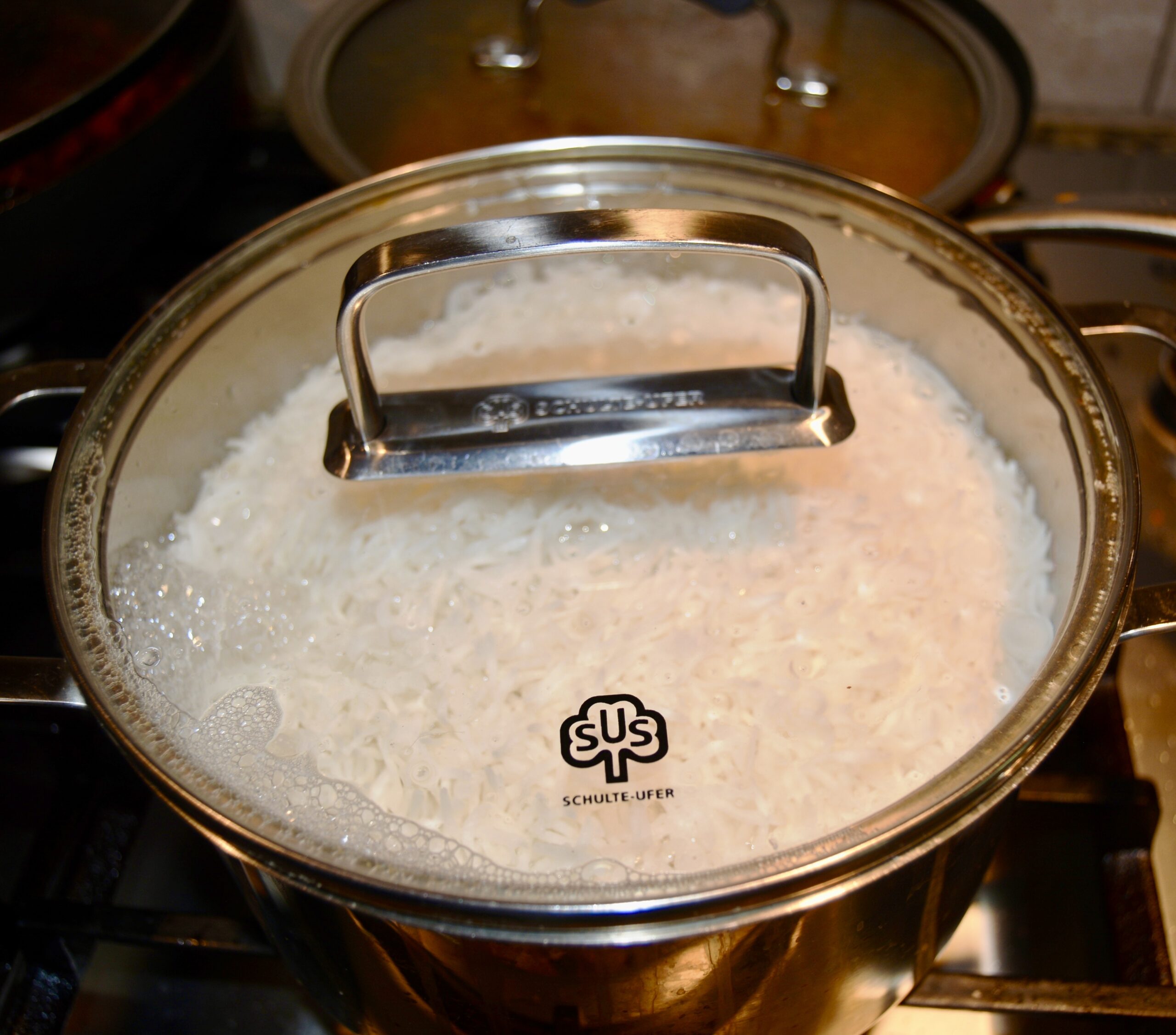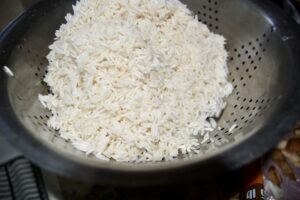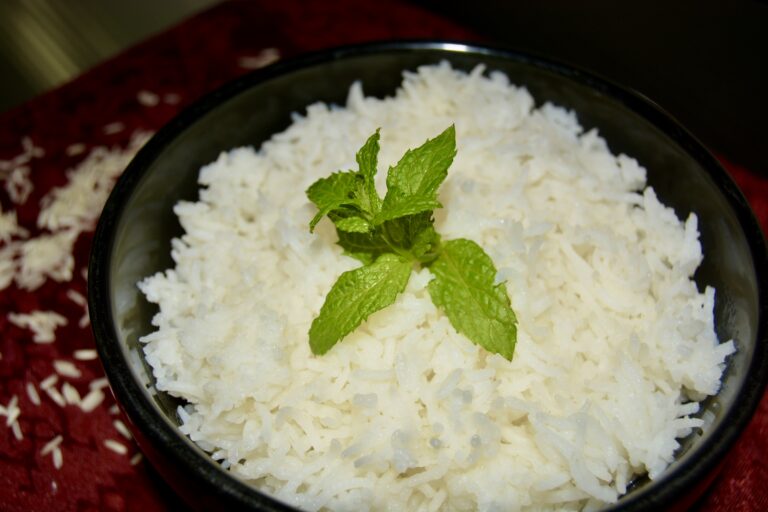Next to wheat, rice is one of India’s leading food staples. Most dals and curries go well with plain boiled white rice. In India, a majority of households use plain cooked rice in their meals at least once during the day. There are different types of rice:
Short-grained—high in starch and tends to be sticky
Medium-grained—longer and a little chewy when cooked
Long-grained rice—less starchy with a firmer texture and excellent for pilafs.
The popular Basmati rice is a long-grained rice grown at the foothills of the Himalayas, both in India and Pakistan. It is mainly used for pilafs and Biryanis and has a nutty popcorn fragrance. The name Basmati originates from the Sanskrit word Vasmati which means fragrant.

Saada Ubala Hua Saphed Chavaal (Plain Boiled White Rice)
Ingredients
- 2 cups white Basmati rice
- 3¾ cups water
Instructions
- Place the rice in a medium bowl.
- Half-fill the bowl with water and wash the grains by gently sifting and rubbing the rice with your fingers. Do this at least 4 times.
- Now add enough water to the bowl just to cover the rice and let the rice soak in the water for 15 minutes. (You can skip the step if you are in a hurry, but add 4 cups of water when boiling).
- Rinse and strain the rice through a rice or fine strainer under running water.
- Transfer the rice to a medium pot and add 3¾-cups of water.
- Stir the rice and bring the uncovered rice to a boil on medium heat. It takes about 15-20 minutes.
- Once it comes to a rolling boil, lower the heat to low, stir gently, and cover the rice with a tight lid.
- Let it simmer on low for about 15 minutes. Try not to uncover the rice and stir at this stage, as it will allow the steam to escape, making the rice drier.
- Turn off the heat and let sit undisturbed for 5-7 minutes. Remove the lid and fluff the rice with a fork by gently lifting the rice up all around the pot, and-breaking up any clumps.
- Transfer to a serving bowl or dish when ready to serve.
- Plain boiled rice tastes good with any dal and any curried-style meats or vegetables. You can serve it as a meal with the usual array of pickles, raitas, papads, and chutneys.
Notes
 Another way to fix rice is to wash and rinse the rice as above. Then in a pot, add about 4 times the water as rice (1:4 ratio). Bring the rice to a boil on medium heat, then reduce the heat and let the rice cook for 15 minutes. Test the grain to see if it's almost done. Turn off the heat. Now strain the rice through a rice strainer or fine sieve. Be careful of the steam! When all the water is drained, give the sieve a shake and put the rice back into the pot Cover with a tight lid and let it sit for 15 minutes before you fluff it.
Most Indian households, when using this method of cooking rice, save the water that has essential minerals and nutrients to drink later. This is especially so in the southern states of India where "kanji' (rice water ) is used as an energy booster for its healthy nutrients.
When we were kids and had an upset stomach, Mama always gave us plain soupy boiled rice and plain yogurt with pepper and salt to settle our stomachs. I still do that to this day whenever anyone in the house has an upset stomach.
Before synthetic starches came on the market in India, this starchy water (kanji) was diluted and used by our dhobis (people who washed our clothes in the absence of washing machines) to starch cotton shirt collars, kurtas, saris, and cotton table linen.
Be aware that cooking times may vary in higher altitudes, and you may need to increase the water by about 1/4 ounce and the resting time by about 5 minutes more.
If you are using white rice other than Basmati, follow the cooking instructions on the packet. Also do this when you are using a manual or electric pressure cooker, microwave oven, or rice cooker.
Another way to fix rice is to wash and rinse the rice as above. Then in a pot, add about 4 times the water as rice (1:4 ratio). Bring the rice to a boil on medium heat, then reduce the heat and let the rice cook for 15 minutes. Test the grain to see if it's almost done. Turn off the heat. Now strain the rice through a rice strainer or fine sieve. Be careful of the steam! When all the water is drained, give the sieve a shake and put the rice back into the pot Cover with a tight lid and let it sit for 15 minutes before you fluff it.
Most Indian households, when using this method of cooking rice, save the water that has essential minerals and nutrients to drink later. This is especially so in the southern states of India where "kanji' (rice water ) is used as an energy booster for its healthy nutrients.
When we were kids and had an upset stomach, Mama always gave us plain soupy boiled rice and plain yogurt with pepper and salt to settle our stomachs. I still do that to this day whenever anyone in the house has an upset stomach.
Before synthetic starches came on the market in India, this starchy water (kanji) was diluted and used by our dhobis (people who washed our clothes in the absence of washing machines) to starch cotton shirt collars, kurtas, saris, and cotton table linen.
Be aware that cooking times may vary in higher altitudes, and you may need to increase the water by about 1/4 ounce and the resting time by about 5 minutes more.
If you are using white rice other than Basmati, follow the cooking instructions on the packet. Also do this when you are using a manual or electric pressure cooker, microwave oven, or rice cooker.



Comments are closed.